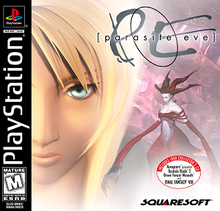
Back باراسايت إيف (لعبة فيديو) Arabic پاراسايت ايڤ (فيديو لعب) ARZ Parasite Eve (Computerspiel) German Parasite Eve (videojuego) Spanish پارازیت ایو Persian Parasite Eve (jeu vidéo) French Parasite Eve (videogioco) Italian パラサイト・イヴ (ゲーム) Japanese 패러사이트 이브 Korean Parasite Eve LLD
| Parasite Eve | |
|---|---|
 North American packaging artwork | |
| Developer(s) | Square |
| Publisher(s) |
|
| Director(s) | Takashi Tokita |
| Producer(s) | Hironobu Sakaguchi |
| Designer(s) | Yoshihiko Maekawa |
| Programmer(s) | Hiroshi Kawai |
| Artist(s) | Tetsuya Nomura |
| Writer(s) | Hideaki Sena Takashi Tokita |
| Composer(s) | Yoko Shimomura |
| Series | Parasite Eve |
| Platform(s) | PlayStation |
| Release | |
| Genre(s) | Role-playing |
| Mode(s) | Single-player |
Parasite Eve[1] is a 1998 role-playing video game developed and published by Square. The game is a sequel to the novel Parasite Eve, written by Hideaki Sena; it is the first game in the Parasite Eve video game series. The story follows New York City police officer Aya Brea over a six-day span in 1997 as she attempts to stop the Eve, a woman who plans to destroy the human race through spontaneous human combustion. Players explore levels set in areas of New York while utilizing a pausable real-time combat system along with several role-playing elements.
Parasite Eve was SquareSoft's first M-rated game, and the first major American and Japanese game development collaboration for the company. It was produced by Hironobu Sakaguchi and directed by Takashi Tokita. Music for the title was composed by Yoko Shimomura who was widely acclaimed for her work to create an "inorganic" and "emotionless" soundtrack that saw two album releases. Parasite Eve received positive reviews; critics praised the graphics and gameplay, but found the overall game too linear and with little replay potential.
The video game adaptation was part of a resurgence of popularity in Japanese horror sparked by the original book, and was released alongside a film adaptation and two manga comics; one based on the book, the other on the video game. The original title was followed by two video game sequels: Parasite Eve II in 1999 and The 3rd Birthday in 2010, and was re-released on the PlayStation Network in 2010. The first two games, Parasite Eve and Parasite Eve II, had shipped over 3 million copies worldwide by 2010.[2]
- ^ Parasite Eve (パラサイト・イヴ, Parasaito Ivu)
- ^ 「パラサイト・イヴ」&「パラサイト・イヴ II」がゲームアーカイブスで配信決定。続編「The 3rd Birthday」発売に向けて遊びつくそう